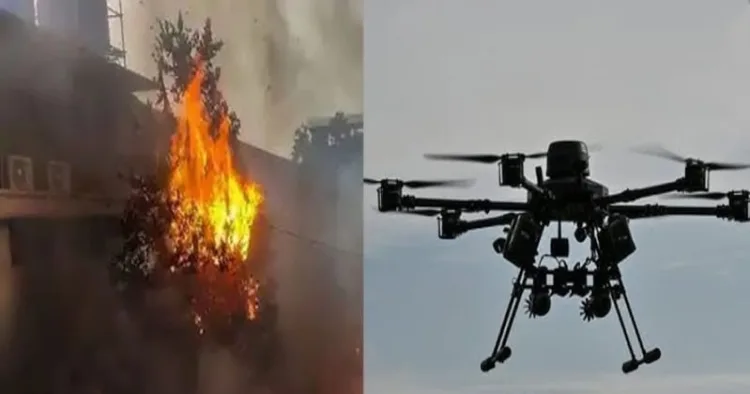Manipur is experiencing a severe escalation in violence, marked by recent drone bomb attacks that have introduced a new and troubling dimension to the state’s ongoing ethnic conflict. Over a seven-hour period, more than 50 bombs were dropped on civilian areas, resulting in the death of a Meitei woman and injuries to several others, including police personnel. The attacks, suspected to be orchestrated by Kuki militants, have continued, with further strikes injuring civilians across various parts of Imphal West district.
In response, Manipur’s Chief Minister, N Biren Singh, has condemned the drone strikes as acts of terrorism, targeting both civilian populations and security forces. The state government has established a high-level committee, led by Additional DGP (Intelligence) Ashutosh Kumar Sinha, to investigate this alarming form of warfare thoroughly.
This situation contrasts sharply with the approach of civil society organisations representing the Meitei and other indigenous communities, which have predominantly resorted to protests and demonstrations. Meanwhile, the Kukis and their front organisation, the Indigenous Tribal Leaders’ Forum (ITLF), appear to exacerbate the conflict rather than seek resolution. The ITLF’s vigorous defence of the drone attacks—despite their being widely viewed as acts of war against India—raises significant questions about their motivations and the broader implications for peace in the region.
The Kukis, who make up about 15 per cent of Manipur’s population, have neither denied nor condemned the attacks. Instead, the ITLF has defended the use of drones, claiming that such technology is easily obtainable and downplaying any external influence. Moreover, the ITLF reportedly operates a dedicated ‘ITLF Drone Squad’ and is involved in spreading false narratives and playing the victim card while seeking support from Christian communities worldwide.
The recent drone attacks in Manipur signify a troubling escalation in violence, orchestrated not merely by local communal tensions but by a calculated strategy involving Kuki militants and insurgent groups from Upper Myanmar and other regions of Northeast India. This strategy seems aimed at establishing a sovereign Christian entity known as Zalengam, which would encompass parts of India, Bangladesh, and Myanmar. Such ambitions highlight a significant challenge to national security and sovereignty, underscoring a broader threat that extends beyond regional conflicts to impact the stability and territorial integrity of the nation.
Kuki a warring tribe?
The Kuki people, an ethnic group mainly found in Manipur and extending into Myanmar and Bangladesh, are part of the broader Kuki-Chin-Mizo ethnic cluster. They have a history marked by frequent regional conflicts and territorial disputes, contributing to the ongoing instability in Manipur. Understanding their past involvement in such conflicts is key to grasping the current tensions in Manipur and their warring attitude.
Kuki-Naga Clashes (1990s): In the early 1990s, Kukis attacked Naga settlements in Manipur’s hills to claim land for ‘Kukiland’. This led to the destruction of Naga villages, the displacement of hundreds, and a retaliatory conflict in 1992 that caused over 230 deaths and significant displacement of Kukis.
Kuki-Paite Clashes (1997-1998): The arrival of displaced Kukis in Churachandpur district intensified tensions with the Paites. Backed by the Kuki National Front (KNF), Kukis’ assertion led to a 17-month violent conflict, resulting in 352 deaths and the displacement of 15,000 people. A peace agreement later established separate identities for Kukis and Zomis.
Kuki-Karbi Clashes (2003-2004): Kukis in Assam’s Karbi Anglong district clashed with indigenous Karbis over political autonomy and territory claims. The conflict, marked by the massacre of 39 Karbis in March 2004, ended with security forces’ intervention.
Hmar-Dimasa Clashes (2003): In Assam’s Dima Hasao district, tensions between Hmars and Dimasas, supported by the Church and NSCN(IM), led to violent clashes and the massacre of 27 Dimasas. The conflict ended in 2004 after peace talks, though tensions remain.
Kukis vs Gorkhas: In Manipur, Kukis targeted the Gorkhas, a small, socio-economically disadvantaged community, pressuring them to leave and facing allegations of forced conversions.
Clashes in Mizoram: In Mizoram, non-Mizo communities, including Marwaris and Biharis, have faced restrictions on property rights. The Brus (Reangs) faced severe discrimination, leading to displacement to refugee camps in Tripura, amid criticisms of the Mizos’ handling of Kuki-Chins from Myanmar.
The recent drone bombings and ongoing attacks on civilian areas in Manipur represent a troubling escalation of Kuki aggression, underscoring an urgent need for decisive government intervention. This escalating violence poses a serious threat to national security. It is crucial for the government to take comprehensive measures to curb the provocations and violence perpetrated by Kuki militants while ensuring the protection and safety of civilians throughout the state.



















Comments